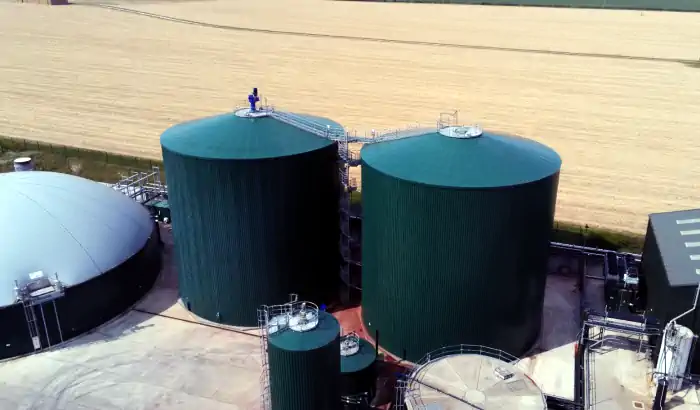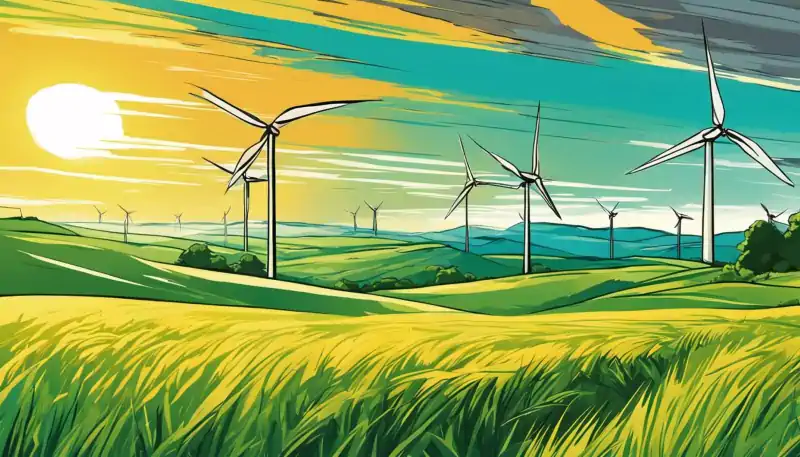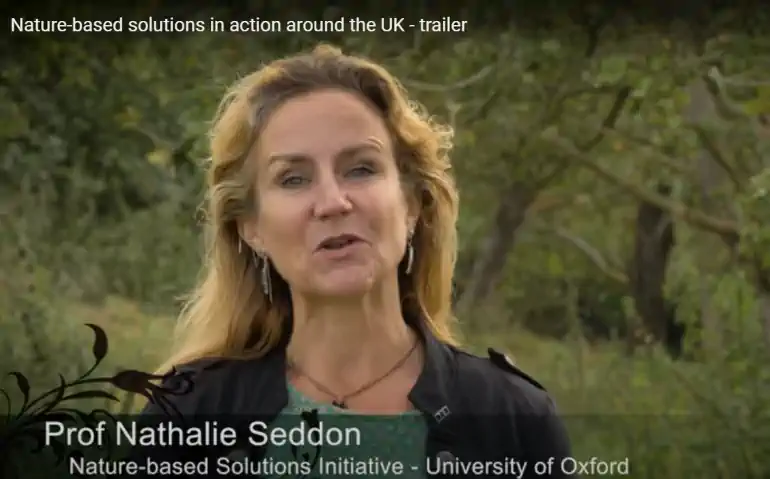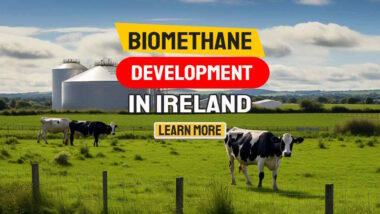How to Get to Net Zero is our guide to help you discover the secrets to achieving net zero emissions and creating a sustainable future. Explore our comprehensive strategies and tips for a greener life!
Are you struggling to understand how to achieve net zero in your life or organisation? There is certainly more to it than just being involved in anaerobic digestion. To start with Net zero refers to the balance between the amount of greenhouse gas that is produced and the amount that is removed from the atmosphere.
This blog post will provide comprehensive strategies and tips on reaching this environmental equilibrium, providing a roadmap for your journey towards sustainability. Ready for a cleaner, greener future? Let's dive right in!
How to Get to Net Zero – Key Takeaways
- Achieving net zero requires a balance between carbon emissions and removals, achieved through reducing emissions and enhancing the planet's capacity to absorb CO2.
- Different levels of residual emissions can be compensated through measures like reforestation or soil management, but they should supplement reduction strategies rather than serve as a free pass to emit more.
- Strategies to reach net zero include embracing renewable energy, converting waste into resources, transitioning to electric vehicles, minimizing business travel, adopting low carbon heating, and generating emission-free electricity on-site.
- Net zero is certainly not just about energy use, although the popular media coverage may lead you to think so.
[boomdevs_toc]
Understanding Net Zero
Net zero is a scientific concept that aims to achieve a balance between carbon emissions and removals, with different levels of residual emissions being compensated through various strategies.
Achieving a balance between carbon emissions and removals
The journey towards achieving net zero begins with balancing carbon emissions and removals. This task calls for a comprehensive approach that includes reducing anthropogenic carbon emissions while enhancing our planet's capacity to absorb the same.
Emphasis lies on industries, vehicles, and power plants as they are major sources of CO2 emissions. Concurrently, initiatives should be made to increase the number of sinks or reservoirs like reforestation, rewilding wetlands, etc. all of which absorb more CO2 than they release.
Further progress can be marked by integrating technologies capable of capturing and storing carbon dioxide from flue gases before it enters the atmosphere – an example being Carbon Capture Storage (CCS). CCS for biogas plants is, of course, a form of low-hanging fruit just waiting to be utilised.
At its core, this balance is pivotal in condemning global warming to history while also allowing room for sustainable human development. The collective undertaking of these measures will inevitably pave the way towards a healthier planet by offsetting CO2 production against removal thus accomplishing ‘Net Zero'.

Differentiating levels of residual emissions and compensating removals
Residual emissions and compensating removals are distinct concepts in the pursuit of net zero.
Residual emissions represent the remaining output of greenhouse gases despite best abatement efforts, such as employing renewable energy sources or reducing waste.
They stand as an unavoidable part of our carbon-costly activities like aviation or heavy industry, which cannot be entirely eliminated. On the other side, compensating removals come into play to balance these irreducible emissions.
This involves removing equivalent amounts of CO2 from the atmosphere through measures such as reforestation or soil management in which the carbon is held in the ground and removed from the natural carbon cycle.
It's crucial to note that these compensations are not a free pass to emit more; instead, they should supplement science-based reduction strategies.
Thus, understanding residual emissions levels is key when setting achievable annual net-zero targets for your climate action plans and managing your business path to net zero effectively without over-reliance on offsets alone.
Net zero as a scientific concept
Net zero, as a scientific concept, essentially revolves around achieving a delicate balance in our atmosphere. This state is attained when the total amount of greenhouse gases we emit into the environment equal those captured or removed.
Carbon dioxide (CO2), one of the primary culprits behind global warming, finds its way back to earth via biological and mechanical processes.
To get to net zero, drastic emission reductions ranging between 90-95% are imperative. Processes such as photosynthesis in plants can help absorb any leftover emissions. It's like having your very own organic carbon capture machine! Alternatively, technologies for carbon dioxide removal can also compensate for residual emissions hard to avoid otherwise.
We call this compensation “carbon credits“. Achievable annual net-zero targets play a significant role in measuring progress towards this pivotal goal.

Strategies to Reach Net Zero
To reach net zero, businesses (and individuals who wish to be “green”) can:
- embrace renewable energy,
- choose to buy sustainable products and use materials with low-embedded carbon
- recycle and whenever possible convert waste into resources,
- adopt high heat insulation to their buildings wherever possible
- transition to electric vehicles wherever renewable electric power is available,
- minimize business and personal travel,
- adopt low-carbon heating, and
- generate emission-free electricity on-site.
This is all very good, but none of these actions alone will get anyone to be “net zero”. So, how do we get to net zero?
For that, a strategy is needed to implement the best possible net zero actions, and each action will need to be built into a Net Zero action plan in which the individual's or organisation's emissions are quantified and the countermeasures are broken down into specific actions over a time period, which for many will be 2050.

Achieving net-zero carbon emissions at the business or individual level involves adopting a variety of strategies that both reduce greenhouse gas emissions and offset any remaining emissions. Here are some top strategies that can be implemented:
For Businesses:
1. Energy Efficiency
1.1 Retrofitting Buildings
Upgrading buildings with energy-efficient insulation, windows, lighting, and HVAC systems to reduce energy consumption.
1.2 Efficient Appliances
Using energy-efficient appliances and machinery in operations to reduce electricity consumption.
2. Renewable Energy
2.1 Onsite Renewable Energy
Installing solar panels, wind turbines, or other renewable energy systems onsite such as bioenergy and biofuels to generate clean energy.
2.2 Purchasing Renewable Energy Certificates
Buying renewable energy certificates (RECs) to offset the business's carbon footprint by supporting renewable energy generation elsewhere.
3. Sustainable Transportation
3.1 Fleet Electrification and Use of Transport Biofuels
Switching to electric vehicles and renewable fuels such as biomethane for company fleets to reduce emissions from transportation. Although not common now, hydrogen may in the future be a favourable renewable energy option.
3.2 Encouraging Sustainable Commutes
Encouraging employees to carpool, use public transport, or cycle to work to reduce emissions from commuting.
4. Waste Reduction
4.1 Recycling and Composting
Implementing recycling and composting programs to reduce waste sent to landfills. The overriding aim will increasingly be to take recycling and composting to new levels and to implement what is currently called the “circular economy”.
4.2 Circular Economy Practices
Adopting circular economy practices, such as reusing and repurposing materials, to reduce waste and the need for new resources. This is hailed as the solution to the next challenge once climate change has been fought back when scarcity of raw materials really begins to bite.
5. Carbon Offsetting
5.1 Carbon Offsetting Programs
Investing in carbon offset projects, such as reforestation or renewable energy projects, to offset the company's remaining carbon emissions.
5.2 Supply Chain Offsets
Working with suppliers to reduce emissions in the supply chain and investing in offset projects to compensate for any remaining emissions.
6. Sustainable Procurement
6.1 Green Procurement
Implementing sustainable procurement policies to choose suppliers and products with lower environmental impacts.
6.2 Local Sourcing
Sourcing goods and services locally to reduce emissions from transportation.
7. Employee Engagement
7.1 Education and Training
Providing education and training to employees on sustainability and encouraging them to take action to reduce their carbon footprints.
7.2 Incentives and Recognition
Offering incentives and recognition to employees who take actions to reduce their carbon footprints.
8. Green Product Development
8.1 Eco-friendly Materials
Utilizing materials that are renewable, recycled, or have a lower carbon footprint in product manufacturing.
8.2 Product Life Cycle Analysis
Conducting a life cycle analysis to identify and minimize the environmental impacts of products throughout their life cycle.
9. Digital Transformation
9.1 Remote Work Policies
Implementing remote work policies to reduce emissions from commuting and office energy consumption.
9.2 Digitalization of Processes
Digitalizing processes to reduce paper usage and streamline operations, thus saving energy and reducing waste.
10. Engaging with Biodiversity and Ecosystem Services
10.1 Habitat Restoration
Engaging in or supporting projects that restore natural habitats and protect biodiversity.
10.2 Sustainable Land Use
Implementing sustainable land use practices in business operations to protect ecosystems and enhance carbon sequestration.
11. Stakeholder Engagement
11.1 Collaboration with NGOs
Collaborating with NGOs and other organizations to develop and implement sustainability initiatives.
11.2 Customer Engagement
Engaging customers in sustainability efforts, such as through recycling programs or educational initiatives.
Need Assistance with Net Zero? Complete our contact form here. For Individuals:
1. Transportation
1.1 Sustainable Transportation
Using public transport, carpooling, cycling, or walking instead of using a personal car to reduce emissions from transportation.
1.2 Electric Vehicles
If possible, use electric vehicles instead of gasoline or diesel vehicles to reduce emissions.
2. Energy Consumption
2.1 Energy Efficiency
Implementing energy-efficient practices at home, such as using LED lighting, sealing leaks, and using energy-efficient appliances.
2.2 Renewable Energy
Using renewable energy sources, such as solar panels or wind turbines, to generate electricity at home.
3. Waste Reduction
3.1 Recycling and Composting
Recycling and composting household waste to reduce the amount of waste sent to landfills.
3.2 Reducing Single-Use Plastics
Minimizing the use of single-use plastics by using reusable containers, bags, and other items.
4. Diet and Lifestyle
4.1 Plant-Based Diet
Adopting a plant-based diet to reduce emissions from the production of meat and dairy products.
4.2 Local and Seasonal Food
Choosing local and seasonal food to reduce emissions from transportation and storage.
5. Carbon Offsetting
5.1 Carbon Offsets
Investing in carbon offset projects to compensate for one's remaining carbon emissions.
5.2 Tree Planting
Participating in tree planting activities to increase carbon sequestration.
6. Water Conservation
Avoidance of the use of excess water for personal use and taking care not to waste water.
8. Eco-friendly Travel
8.1 Sustainable Travel Choices
Opting for travel options with lower carbon footprints, such as trains instead of planes for short trips.
8.2 Carbon Offset Programs
Utilizing carbon offset programs to offset emissions from personal travel.
9. Community Involvement
9.1 Community Gardens
Participating in or supporting community gardens to promote local food production and community engagement in sustainability.
9.2 Grassroots Movements
Joining grassroots movements to advocate for policy changes that support the transition to a net-zero society.
10. Lifelong Learning
10.1 Continuous Education
Engaging in continuous education to stay informed about the latest developments in sustainability and climate science.
10.2 Skill Development
Developing skills that contribute to sustainability, such as learning how to grow your own food or repair household items instead of buying new ones.
11. Financial Choices
11.1 Sustainable Investments
Choosing to invest in sustainable funds or companies that are committed to reducing their carbon footprints.
11.2 Conscious Consumption
Being a conscious consumer by considering the environmental impacts of products and services before making a purchase.
By adopting a comprehensive approach that addresses various aspects of sustainability, businesses and individuals can significantly contribute to the global effort to achieve net-zero emissions. It involves not only reducing emissions but also engaging in activities that restore and protect the environment and foster a culture of sustainability in society.
Embracing renewable energy sources
Strategies to Reach Net Zero
To reach net zero, businesses (and individuals who wish to be “green”) can:
- embrace renewable energy,
- choose to buy sustainable products and use materials with low-embedded carbon
- recycle and whenever possible convert waste into resources,
- adopt high heat insulation to their buildings wherever possible
- transition to electric vehicles wherever renewable electric power is available,
- minimize business and personal travel,
- adopt low-carbon heating, and
- generate emission-free electricity on-site.
This is all very good, but none of these actions alone will get anyone to be “net zero”. So, how do we get to net zero?
For that, a strategy is needed to implement the best possible net zero actions, and each action will need to be built into a Net Zero action plan in which the individual's or organisation's emissions are quantified and the countermeasures are broken down into specific actions over a time period, which for many will be 2050.

Achieving net-zero carbon emissions at the business or individual level involves adopting a variety of strategies that both reduce greenhouse gas emissions and offset any remaining emissions. Here are some top strategies that can be implemented:
For Businesses:
1. Energy Efficiency
1.1 Retrofitting Buildings
Upgrading buildings with energy-efficient insulation, windows, lighting, and HVAC systems to reduce energy consumption.
1.2 Efficient Appliances
Using energy-efficient appliances and machinery in operations to reduce electricity consumption.
2. Renewable Energy
2.1 Onsite Renewable Energy
Installing solar panels, wind turbines, or other renewable energy systems onsite such as bioenergy and biofuels to generate clean energy.
2.2 Purchasing Renewable Energy Certificates
Buying renewable energy certificates (RECs) to offset the business's carbon footprint by supporting renewable energy generation elsewhere.
3. Sustainable Transportation
3.1 Fleet Electrification and Use of Transport Biofuels
Switching to electric vehicles and renewable fuels such as biomethane for company fleets to reduce emissions from transportation. Although not common now, hydrogen may in the future be a favourable renewable energy option.
3.2 Encouraging Sustainable Commutes
Encouraging employees to carpool, use public transport, or cycle to work to reduce emissions from commuting.
4. Waste Reduction
4.1 Recycling and Composting
Implementing recycling and composting programs to reduce waste sent to landfills. The overriding aim will increasingly be to take recycling and composting to new levels and to implement what is currently called the “circular economy”.
4.2 Circular Economy Practices
Adopting circular economy practices, such as reusing and repurposing materials, to reduce waste and the need for new resources. This is hailed as the solution to the next challenge once climate change has been fought back when scarcity of raw materials really begins to bite.
5. Carbon Offsetting
5.1 Carbon Offsetting Programs
Investing in carbon offset projects, such as reforestation or renewable energy projects, to offset the company's remaining carbon emissions.
5.2 Supply Chain Offsets
Working with suppliers to reduce emissions in the supply chain and investing in offset projects to compensate for any remaining emissions.
6. Sustainable Procurement
6.1 Green Procurement
Implementing sustainable procurement policies to choose suppliers and products with lower environmental impacts.
6.2 Local Sourcing
Sourcing goods and services locally to reduce emissions from transportation.
7. Employee Engagement
7.1 Education and Training
Providing education and training to employees on sustainability and encouraging them to take action to reduce their carbon footprints.
7.2 Incentives and Recognition
Offering incentives and recognition to employees who take actions to reduce their carbon footprints.
8. Green Product Development
8.1 Eco-friendly Materials
Utilizing materials that are renewable, recycled, or have a lower carbon footprint in product manufacturing.
8.2 Product Life Cycle Analysis
Conducting a life cycle analysis to identify and minimize the environmental impacts of products throughout their life cycle.
9. Digital Transformation
9.1 Remote Work Policies
Implementing remote work policies to reduce emissions from commuting and office energy consumption.
9.2 Digitalization of Processes
Digitalizing processes to reduce paper usage and streamline operations, thus saving energy and reducing waste.
10. Engaging with Biodiversity and Ecosystem Services
10.1 Habitat Restoration
Engaging in or supporting projects that restore natural habitats and protect biodiversity.
10.2 Sustainable Land Use
Implementing sustainable land use practices in business operations to protect ecosystems and enhance carbon sequestration.
11. Stakeholder Engagement
11.1 Collaboration with NGOs
Collaborating with NGOs and other organizations to develop and implement sustainability initiatives.
11.2 Customer Engagement
Engaging customers in sustainability efforts, such as through recycling programs or educational initiatives.
Need Assistance with Net Zero? Complete our contact form here.For Individuals:
1. Transportation
1.1 Sustainable Transportation
Using public transport, carpooling, cycling, or walking instead of using a personal car to reduce emissions from transportation.
1.2 Electric Vehicles
If possible, use electric vehicles instead of gasoline or diesel vehicles to reduce emissions.
2. Energy Consumption
2.1 Energy Efficiency
Implementing energy-efficient practices at home, such as using LED lighting, sealing leaks, and using energy-efficient appliances.
2.2 Renewable Energy
Using renewable energy sources, such as solar panels or wind turbines, to generate electricity at home.
3. Waste Reduction
3.1 Recycling and Composting
Recycling and composting household waste to reduce the amount of waste sent to landfills.
3.2 Reducing Single-Use Plastics
Minimizing the use of single-use plastics by using reusable containers, bags, and other items.
4. Diet and Lifestyle
4.1 Plant-Based Diet
Adopting a plant-based diet to reduce emissions from the production of meat and dairy products.
4.2 Local and Seasonal Food
Choosing local and seasonal food to reduce emissions from transportation and storage.
5. Carbon Offsetting
5.1 Carbon Offsets
Investing in carbon offset projects to compensate for one's remaining carbon emissions.
5.2 Tree Planting
Participating in tree planting activities to increase carbon sequestration.
6. Water Conservation
Avoidance of the use of excess water for personal use and taking care not to waste water.
8. Eco-friendly Travel
8.1 Sustainable Travel Choices
Opting for travel options with lower carbon footprints, such as trains instead of planes for short trips.
8.2 Carbon Offset Programs
Utilizing carbon offset programs to offset emissions from personal travel.
9. Community Involvement
9.1 Community Gardens
Participating in or supporting community gardens to promote local food production and community engagement in sustainability.
9.2 Grassroots Movements
Joining grassroots movements to advocate for policy changes that support the transition to a net-zero society.
10. Lifelong Learning
10.1 Continuous Education
Engaging in continuous education to stay informed about the latest developments in sustainability and climate science.
10.2 Skill Development
Developing skills that contribute to sustainability, such as learning how to grow your own food or repair household items instead of buying new ones.
11. Financial Choices
11.1 Sustainable Investments
Choosing to invest in sustainable funds or companies that are committed to reducing their carbon footprints.
11.2 Conscious Consumption
Being a conscious consumer by considering the environmental impacts of products and services before making a purchase.
By adopting a comprehensive approach that addresses various aspects of sustainability, businesses and individuals can significantly contribute to the global effort to achieve net-zero emissions. It involves not only reducing emissions but also engaging in activities that restore and protect the environment and foster a culture of sustainability in society.
To kick-start the journey towards a net-zero future, renewable energy sources play an indispensable role. Here's how embracing them can help:
- Solar and wind power replace fossil fuels, reducing emissions significantly.
- Geothermal energy offers unlimited supply and reduces dependency on volatile oil markets.
- Bioenergy converts waste to energy, achieving waste reduction and energy production simultaneously.
- Hydropower harnesses the potential of rivers and dams without contributing to carbon emissions.
- Wave and tidal energy (although underdeveloped and in need of investment) may be worth considering for businesses and individuals with local access to natural resources such as a mill-race, or fast-flowing river into which a hydraulic ram or similar may be placed, for renewable energy supply.
- Use of renewable energy can be a “quick win” which provides positive feedback and further encourages businesses to adopt green practices, aligning with their net-zero plans.
- Green tariffs allow corporations to buy renewable electricity directly from an energy supplier or generator.
- Innovations in battery storage technologies make renewable sources more reliable and effective.
- Offshore wind farms provide large-scale power generation capacity while preserving land resources.
- Building-integrated photovoltaics turn buildings into solar power plants, fostering a clean local environment.
5 Tips for Those Seeking Easy Net Zero Gains
There is no need to wait for new technology to implement the following:
1. Reducing waste and converting it into a resource via industrial synergy
Reducing waste and giving it a new purpose makes it a significant strategy on the path to net zero. Various ways to achieve this include:
- Promoting recycling efforts among businesses and individuals
- Encouraging the use of compostable materials in manufacturing
- Turning organic waste into renewable energy through biodigestion
- Using recyclable packaging in logistics and supply chain management
- Employing construction waste as raw material for other projects
- Re-purposing e-waste through comprehensive recovery programs.
2. Transitioning to electric vehicles
Transitioning to electric vehicles marks a significant step in the journey towards Net Zero. Here are some key factors that highlight its importance for all but heavy vehicle use:
- Electric vehicles stand at the forefront of reducing net carbon emissions.
- They play an instrumental role in achieving zero emissions by 2050, according to recent studies.
- This shift has been embraced by various governments globally, with the UK government viewing it as crucial for attaining Net Zero.
- Not only does transitioning to electric vehicles reduce harmful pollutants but also supports increased demand for renewable energy sources.
- The McKinsey analysis indicates a potential surge in the adoption of these types of vehicles during this transition period.
- Hidden one-off costs such as installing home chargers highlight some of the financial barriers involved in this shift.
- Route optimization and mileage reduction in goods vehicles further emphasize the role of electric models in reaching carbon neutrality.
3. Minimizing business travel
Minimising business travel plays a crucial role in achieving the net zero target. Here are some effective strategies that businesses can implement:
- Committing to substantial emission reductions: Several firms, such as EY, have pledged to cut their business travel emissions by 35% by 2025. Other companies aim for a 50% reduction by 2030.
- Encouraging sustainable choices: Travel entities can aid consumers in making eco-friendly decisions. This move comprises presenting sustainable alternatives and incorporating sustainability into their operational models.
- Focusing on priority areas: Groups like McKinsey & Company and Skift Research suggest concentrating on four high-priority aspects to expedite the transition to net-zero travel.
- Implementing practical solutions: Businesses can apply methods like reducing goods vehicles' number and mileage, optimising route planning, and tracking carbon emissions to reach carbon net zero effectively.
- Supply chain management: Involve your business supply chain in your net zero plan for broader impact.
4. Adopting low carbon heating
Adopting low carbon heating is a crucial step towards achieving net zero emissions. Here are some strategies to consider:
- Upgrading heating systems with energy-efficient alternatives.
- Installing heat pumps that extract heat from the ground or air.
- Using biomass boilers that burn organic materials for heat.
- Implementing district heating systems that distribute heat from a central source.
But usually only after insulating buildings to reduce heat loss.
5. Generating emission-free electricity on-site
Generating emission-free electricity on-site is also seen by many as crucial for achieving net zero emissions, although carbon emission during manufacture does need consideration. Here are some strategies to consider:
- Installing solar panels on rooftops or open spaces to harness the power of the sun.
- Utilizing wind turbines to generate clean and renewable energy.
- Implementing hydropower systems to take advantage of flowing water sources.
- Incorporating geothermal energy systems that tap into the Earth's heat.
- Deploying biomass plants that convert organic waste into usable energy.
The Role of Forests and Soils
Forests and soils play a crucial role in achieving net zero emissions, through reforestation, sustainable land use practices, and restoration efforts. Discover how these natural resources can help combat climate change.
Read more to find out!
Reforestation and soil management for carbon uptake
Reforestation and soil management play crucial roles in capturing and storing carbon emissions. To achieve net zero targets, it is important to implement these strategies effectively. Here are some ways to promote carbon uptake through reforestation and soil management:
- Planting trees: Increase the number of trees in deforested areas to enhance carbon absorption.
- Restoring degraded forests: Revitalize damaged forests by planting native tree species and providing proper care.
- Sustainable land use practices: Implement responsible land management techniques that maintain healthy soils capable of sequestering carbon.
- Promoting agroforestry: Combine tree planting with agricultural practices to improve soil fertility and enhance carbon storage.
- Protecting wetlands and peat bogs: Preserve these natural habitats as they serve as significant carbon sinks.
- Managing forest soils: Ensure proper nutrient cycling and organic matter decomposition to optimize carbon storage.
Promoting sustainable land use practices
To achieve net zero, it is crucial to promote sustainable land use practices. This involves implementing strategies that minimize the impact on the environment and maximize the benefits for both people and biodiversity. Here are some key practices that can contribute to a more sustainable land use:
- Implementing agroforestry systems: Combining agriculture with forestry, such as planting trees alongside crops or incorporating livestock grazing in woodland areas, can help sequester carbon and improve soil health.
- Adopting regenerative farming practices: Practices like crop rotation, cover cropping, and reduced tillage can enhance soil fertility, increase water retention, and reduce the need for chemical inputs.
- Protecting natural habitats: Preserving and restoring natural habitats like wetlands, grasslands, and forests not only helps to combat climate change but also provides important habitats for wildlife.
- Encouraging responsible land management: Encouraging landowners to adopt sustainable practices like avoiding deforestation, minimizing land degradation, and using eco-friendly pest control methods.
- Promoting sustainable forestry: Sustainable forestry practices involve selectively harvesting trees and replanting them to maintain the health of forests while also ensuring a continuous supply of timber.
- Supporting organic farming: Organic farming reduces reliance on synthetic fertilizers and pesticides, which create high carbon emissions during mining and manufacture and can have detrimental effects on soil health and biodiversity.
- Enhancing soil carbon sequestration: Practices like applying compost or biochar to agricultural fields can increase carbon storage in the soil.
Restoring wetlands and peat bogs as carbon sinks
Restoring wetlands and peat bogs is a crucial strategy to achieve net-zero carbon emissions. It involves the following actions:
- Restoring peatlands to their natural state: This helps stop carbon emissions from these areas and even revives them to store carbon.
- Absorbing and storing carbon dioxide: Wetlands and peat bogs act as important carbon sinks as they re-grow, absorbing and storing large amounts of carbon dioxide.
- Preventing climate change effects: Peatland restoration can be critical in preventing and mitigating the effects of climate change. Closing drainage paths from peatland to regrow marshland also helps preserve biodiversity and minimize flood risk.
- Enhancing carbon storage: Rewetting drained peatlands and allowing sphagnum moss to accumulate leads to net climate benefits by reducing carbon dioxide emissions and enhancing carbon storage.
Rewilding
Rewilding plays a crucial role in achieving net zero emissions by restoring natural habitats and allowing them to absorb carbon from the air. This process involves creating new ecosystems and expanding existing ones, which helps remove carbon dioxide and store it in plants, trees, and soil.
The UK government has committed to rewilding 500,000 hectares of land by 2043 as part of its efforts towards zero emissions. By promoting regenerative forestry practices and preserving soils, rewilding can not only help combat climate change but also enhance biodiversity by providing habitats for various plant and animal species. But, food production must not be diminished by rewilding.
It is an effective strategy that brings multiple benefits to our environment while contributing to the global goal of reaching net zero emissions.
Overcoming the Net Zero Targeting Challenges
Net zero strategies will need to overcome the following common challenges:
- Overcoming financial barriers to funding decarbonisation policies and where applicable securing necessary subsidies for net-zero initiatives.
- Addressing both national and company infrastructure limitations to support the transition to a net-zero economy.
- Educating the public and staff about the importance of net zero to the company's future and how important it is for every individual within the organisation to actively contribute toward achieving the targets set.
- Collaborating with governments and policymakers, often via industry associations and at times lobbying politicians, to create net zero supportive regulations and policies.
- Involving directors, shareholders and stakeholders to alleviate their concerns about company viability during the planning and implementation of net-zero strategies.
Now let's look at each of these in more detail:
Net Zero Financial and other barriers
Financial barriers and subsidies present challenges in achieving net zero targets. Here are some key points to consider:
- Limited access to financing options for homeowners and tenants can hinder their ability to implement net zero practices.
- Most businesses, especially smaller ones, face complex barriers specific to their industry when transitioning to net zero. For example, using waste as a resource may be impeded by the legal framework for licencing waste operations.
- A lack of awareness about net zero practices among individuals and organizations can impede progress.
- The financial institutions that play a crucial role in supporting the transition by committing to net zero targets and developing climate transition plans may be hindered by state laws governing business.
UK Net Zero support subsidies
- Government subsidies can help incentivize businesses and individuals to adopt low-carbon practices.
- The UKIB (UK Infrastructure Bank) has £22 billion of financial capacity, which a UK Gov policy report stated in 2021 can be utilized for funding projects aligned with net zero goals.
- The UK Gov 2023 Progress Report to Parliament aims to address financial barriers in low-carbon farming practices.

Infrastructure limitations
Infrastructure limitations must always be recognised when creating a net zero company or individual strategy plan. They frequently pose significant challenges in achieving net zero emissions. Here are some key considerations:
- Outdated systems: Aging infrastructure, such as power plants and transportation networks, may lack the efficiency needed to support sustainable practices.
- Insufficient capacity: The existing infrastructure may not have the capacity to accommodate the increased demand for renewable energy sources or electric vehicles.
- Limited accessibility: In certain areas, especially rural or remote locations, the lack of accessible infrastructure hinders the implementation of clean energy solutions.
- Cost barriers: Upgrading infrastructure to support net zero goals can be costly, requiring substantial investments in new technologies and equipment.
- Grid integration challenges: Incorporating large-scale renewable energy sources into the electricity grid presents technical and logistical difficulties that need to be addressed.
- Interconnected systems: Achieving net zero requires a coordinated approach across various sectors, such as transport, housing, and manufacturing. Interconnecting these systems is complex and requires careful planning.
- Public acceptance: Implementing new infrastructure projects often faces resistance from local communities due to concerns about visual impact or disruption during construction.
Public Education
Public education plays a crucial role in achieving net zero goals. It raises awareness, dispels myths, and motivates individuals to take action. Here are some ways in which public education can contribute to the transition towards a sustainable future:
- Spreading awareness: By educating the public about the impacts of climate change and the urgent need for action, we can build a collective understanding and sense of responsibility.
- Encouraging behaviour change: Public education campaigns can promote environmentally-friendly behaviours such as energy conservation, waste reduction, and sustainable transportation options.
- Empowering communities: Providing information and resources enables individuals and communities to make informed choices and actively participate in climate action initiatives.
- Engaging youth: Education is crucial in inspiring young people to become environmental advocates and leaders. By integrating sustainability into school curriculums, we can nurture a generation that is committed to net zero goals.
- Collaborating with stakeholders: Public education efforts should involve partnerships with local governments, NGOs, businesses, and other stakeholders to ensure wide-reaching impact and sustained progress.
- Fostering innovation: By fostering a culture of learning and curiosity, public education can encourage innovation in renewable energy solutions, sustainable agriculture practices, and other areas critical for achieving net zero targets.
- Addressing climate justice: Public education should emphasize the disproportionate impact of climate change on marginalized communities. It can create avenues for dialogue on equitable solutions that prioritize social justice.
- Overcoming misinformation: Through clear communication channels and fact-based messaging, public education helps combat misinformation surrounding climate change science.

Collaboration with governments and policymakers
Governments and policymakers are essential partners in the journey towards achieving net zero emissions. They play a crucial role in overcoming challenges and driving sustainable changes. Here are some ways collaboration with governments and policymakers can contribute to reaching net zero:
- Setting clear goals and targets: Governments can establish ambitious targets for reducing carbon emissions and work with policymakers to develop effective strategies.
- Policy development: Governments can create policies that support the transition to renewable energy sources, encourage waste reduction, promote sustainable land use practices, and incentivize low-carbon technologies.
- Funding and subsidies: Governments can provide financial support and incentives to businesses and individuals who adopt sustainable practices or invest in clean technologies.
- Infrastructure investment: Collaboration between governments and policymakers can lead to investments in infrastructure that supports the widespread adoption of renewable energy, electric vehicle charging stations, and other green technologies.
- Public education: Governments have the power to educate the public about the importance of net zero emissions, climate change, and individual actions that can make a difference.
- International cooperation: Collaboration with other governments on a global scale is necessary for addressing climate change comprehensively. Sharing knowledge, resources, and best practices can accelerate progress towards net zero.
Shareholder and stakeholder involvement in net-zero planning
Stakeholders, including shareholders, have a crucial role to play in the planning process for achieving net-zero goals. However, shareholder pressure and reporting cycles often prioritize short-term profitability over long-term sustainability objectives.
To overcome this challenge, it is important to involve not only shareholders but also other stakeholders such as government officials, waste management professionals, energy companies, and environmental engineers.
By engaging these stakeholders and aligning their interests with net-zero planning, we can ensure that comprehensive strategies are developed and implemented to transition towards a sustainable future.
Responsible staffing of net-zero policy-making
Organizations play a crucial role in achieving the goal of net zero carbon emissions, and responsible staffing is vital for effective policy-making and target compliance. By ensuring that they have the right expertise and resources, organizations can develop and implement robust net-zero policies.
This includes hiring environmental researchers, waste management professionals, government officials, sustainability advocates, energy companies, landfill operators, environmental engineers, and policymakers who can contribute their knowledge and skills to drive progress towards net zero.
With responsible staffing in place, organizations can overcome challenges and make significant strides towards a sustainable future.
Setting Net Zero Targets
Setting net zero targets requires careful consideration and planning to avoid front-loaded emission reductions, take a comprehensive approach to emission reductions, utilize carbon dioxide removal technology cautiously, and effectively regulate carbon offsets.
Discover how setting net zero targets can contribute to a sustainable future:
Avoiding front-loaded emission reductions
Front-loaded emission reductions should not be avoided when planning for net-zero targets.
Urgent action is required to reduce emissions intensity in order to achieve the goal of a net-zero economy so adopting all the possible low-cost reductions early may appeal. Nevertheless, the overriding goal should be to make steady progress and actually arrive as planned at net zero on the date chosen.
Companies that prioritize early emission reductions can benefit economically by decreasing the environmental impact of their processes and products. It is crucial to decarbonize legacy products and processes as part of the transition towards achieving net zero emissions by 2050, which has significant economic and societal implications globally.
However, the danger lies in the years to come in being able to consistently meet a set target of “x” percentage reduction annually. Failing to meet an annual target is disheartening and the ability to comply in all years of a net zero target plan is important.
Taking immediate steps to reduce emissions is essential in addressing climate change and building a sustainable future, but always allow space for future incremental reductions.
Taking a comprehensive approach to emission reductions
Reducing emissions requires a comprehensive approach that tackles all greenhouse gases, not just CO2Text in panel
- Implement energy-efficient measures to reduce overall energy consumption.
- Transition to renewable energy sources like solar and wind power.
- Promote sustainable transportation options such as electric vehicles and public transit.
- Improve waste management practices, including recycling and composting.
- Encourage the use of low-carbon technologies in manufacturing and industry.
- Invest in research and development of carbon capture and storage technologies.
- Support sustainable land use practices, such as reforestation, biochar production, and soil conservation.
Cautious use of carbon dioxide removal technology
Carbon dioxide removal technology plays a crucial role in achieving net zero emissions. This approach involves removing carbon dioxide from the atmosphere and storing it elsewhere, effectively reducing greenhouse gas concentrations.
However, caution must be exercised when deploying this technology to ensure its effectiveness and minimize any unintended consequences. It is important to carefully assess the environmental impact and sustainability of different carbon removal methods before implementing them on a large scale.
Additionally, regulation and oversight are essential to ensure that carbon offsets are accurately accounted for and do not compromise the overall goal of achieving net zero emissions.
Effective regulation of carbon offsets
Effective regulation of carbon offsets is crucial for achieving net zero targets. This ensures that the carbon offsets purchased or invested in by companies are truly reducing emissions and contributing to sustainability efforts.
It also helps prevent greenwashing and ensures transparency in carbon offset projects. Effective regulation of carbon offsets involves:
- Monitoring and verifying the quality and credibility of carbon offset projects.
- Setting rigorous standards and criteria for carbon offset projects.
- Implementing robust measurement, reporting, and verification processes.
- Establishing a centralized registry or platform to track and document carbon offset transactions.
- Conducting regular audits and inspections to ensure compliance with regulations.
- Enforcing penalties for non-compliance or fraudulent practices.
- Collaborating with international organizations to develop global guidelines and best practices for carbon offsetting.
Benefits of Achieving Net Zero
Achieving net zero emissions comes with a range of benefits for businesses and the environment. Firstly, adopting net zero strategies can have positive financial impacts. Businesses that commit to reducing their carbon footprint can attract new customers who prioritize sustainability.
Additionally, implementing energy-efficient measures and transitioning to renewable energy sources can lead to cost savings in the long run.
Secondly, achieving net zero emissions is crucial for enhancing business resilience. By reducing reliance on fossil fuels and embracing sustainable practices, businesses are better equipped to adapt to future changes in regulations and market demands.
This flexibility helps them stay ahead of potential disruptions and build a more stable foundation for growth.
Lastly, reaching net zero has significant environmental advantages. It plays a vital role in mitigating climate change by curbing greenhouse gas emissions. This not only contributes to global efforts towards limiting temperature rise but also reduces the severity of extreme weather events such as droughts and floods.
Overall, adopting a net-zero approach brings economic opportunities, strengthens business resilience, and helps protect our planet from the adverse effects of climate change.
How to Get to Net Zero – End of Article Summary
In conclusion, achieving net zero is not only crucial for the future of our planet but also an achievable goal. By implementing strategies such as embracing renewable energy sources, reducing waste, and transitioning to electric vehicles, we can make significant progress towards a sustainable future.
With the involvement of governments, businesses, and individuals committed to net zero, we can create a world where carbon emissions are balanced by removal from the atmosphere.
Taking action towards a sustainable future with Net Zero
Achieving a sustainable future requires taking action towards Net Zero. This means finding ways to balance carbon emissions and removals, while also embracing renewable energy sources, reducing waste, transitioning to electric vehicles, and adopting low-carbon heating.
Additionally, reforestation and soil management can play a crucial role in capturing carbon from the atmosphere. Overcoming challenges like financial barriers and infrastructure limitations will require collaboration with governments, stakeholders, and policymakers.
By setting achievable annual net zero targets and involving businesses throughout the supply chain, we can build custom climate action plans that decrease emissions and pave the way for a more environmentally friendly future.
Need Assistance with Net Zero? Complete our contact form here.How to Get to Net Zero – FAQs
1. What does ‘getting to net zero' mean for a business?
Getting to net zero involves planning your business path such that you balance the amount of greenhouse gases produced and removed from the atmosphere.
2. How can businesses plan their path to net zero?
Businesses can achieve this by reducing emissions, implementing sustainable practices, and involving their supply chain in sustainability efforts.
3. Does getting to net zero involve just direct operations of my business?
No, achieving net zero extends beyond direct operations; it demands involvement from your supply chain too, ensuring they follow sustainable measures.
4. Why is involving the supply chain important in reaching net zero?
Supply chains often account for significant portions of a company's carbon footprint. Hence, they play an essential role in helping businesses reduce overall emissions and reach their goal of becoming Net Zero.
Need Assistance with Net Zero? Complete our contact form here.






